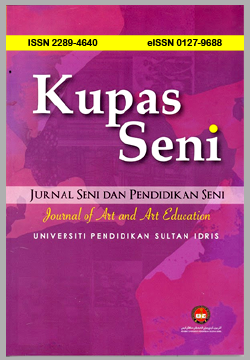The Iban’s Community perceptions of Pua Sungkit Weaving at Batang Ai
Persepsi Masyarakat Iban terhadap Tenunan Pua Sungkit di Batang Ai
DOI:
https://doi.org/10.37134/kupasseni.vol8.2.3.2020Keywords:
pua sungkit, weaving, perception, maintenance and conservationAbstract
This study aims to analyze the Iban community's perception of pua sungkit weaving in Batang Ai. The three objectives of this study are to identify pua sungkit in the Batang Ai area, examine the function of pua sungkit in the life of the Iban community and see the changes in the making of pua sungkit involving ten longhouses in Batang Ai, Lubok Antu. To achieve these objectives, researchers implement library search and field study by applying cultural and art theory. Cultural theory is related to the traditions, and daily activities performed, while art theory shows the heritage and handicrafts produced by the Iban community. The interview and questionnaire sessions conducted involved a total of fifty respondents and fourteen informants in explaining the relationship between the making of pua sungkit and the culture of the Iban community. The interview session found that some informants who were still healthy were willing to teach; the rest did not want due to their age. The questionnaire session showed that the majority of respondents agreed that pua sungkit is a substitute for pua kumbu. The findings show that there are still many among the Iban community who are interested and skilled in weaving and producing pua sungkit, the young Iban women are now trying to learn to weave. In conclusion, the weaving heritage is still relevant and preserved because of the functions of pua sungkit as a unique piece of traditional women's clothing, a special fabric used in religious ritual ceremonies, a wedding gift and as a decorative item at home. The implication is that there is a proposal to create a weaving training centre, to build a website as a marketing platform for the local pua sungkit weaving, and make it as one of the elective subjects in schools as to preserve and conserve the weaving cultural heritage.
Downloads
References
Augustine Anggat Ganjing. (1991). Asas Ukiran Iban Satu Pengenalan. Kuala Lumpur. Dewan Bahasa Dan Pustaka.
Barbara Leigh. (2000). The Changing Face Of Malaysian Crafts Identity, Industry, And Ingenuity. Singapore. Oxford University Press.
Dalilah Mohd Rubi, Suriani Mohamed, Ridzwan Che’ Ros, Nor Asimah Zakaria. (2012). Pola Pemilihan Rekaan Dan Produk Batik Malaysia Dalam Kalangan Remaja: Universiti Pendidikan Sultan Idris.
Datin Amar Margaret Linggi. (2001). Ties that Bind:Iban ikat weaving.(2nd ed.). Kuching: The Tun Jugah Foundation.
David Kaplan., & Albert A. Manners. (1999). Teori Budaya. Yogyakarta. Pustaka Pelajar.
Devourie Gail., & Lorita Jeros. (2007). Motif Iban Dalam Pengaplikasian Seni Tampak Di Malaysia. Kuching: Universiti Malaysia Sarawak.
Dewan Bahasa Dan Pustaka. (1989). Kamus Bahasa Iban – Bahasa Malaysia. Kuala Lumpur. Dewan Bahasa Dan Pustaka.
Dewan Bahasa Dan Pustaka. (2010). Kamus Dewan.(Edisi Keempat). Kuala Lumpur. Dewan Bahasa Dan Pustaka.
Edric Ong. (1996). Pua Iban Weavings Of Sarawak. Kuching. Society Atelier Sarawak.
Grant Pooke., & Diana Newall. (2008). Art History The Basics. New York. Routledge.
Heidi Munan. (1989). Images Of Asia Sarawak Crafts Methods, Materials, And Motifs. Singapore. Oxford University Press.
Heribert Amann. (2013). Textiles From Borneo: Iban Kantu Ketungau and Mualang Peoples. Milan: 5 Continents Editions.
Janet Rata Noel. (2016). "Pua Kumbu And The Politics Of Heritage" dlm Ngingit (Isssue 7 February). Kuching: The Tun Jugah Foundation.
Jimbun Tawai. (2013). Ngepan Asal Iban. Kuching. Yayasan Kebudayaan Dayak.
Joseph Fischer. (1979). Threads Of Tradition: Textiles Of Indonesia And Sarawak. California: University Of California.
Karol Berger. (2000). A Theory Of Art. New York. Oxford University Press.
Kim Jane Saunders. (1997). Contemporary Tie And Dye Textiles Of Indonesia. Singapore: Oxford University Press.
Lydia Van Gelder. (1980). Ikat. New York: Watson-Guptill Publications.
Nalong Buda., & Johnny Chuat. (2009). Iban Pegai Rajah Brooke. Bintulu. Pegari Iban Production.
Noria Tugang. (2014). Pua Identiti Dan Budaya Masyarakat Iban. Kota Samarahan: Penerbit Universiti Malaysia Sarawak.
Norwani Mohd. Nawawi. (1994). Malaysian Songket. Kuala Lumpur: Dewan Bahasa dan Pustaka.
Mohd Zahuri Khairani, Mohammad Rusdi Mohd Nasir. (2012). Repositioning Pua Kumbu And Batik Through Artistic Practice : Globalising The Local By Drawing Upon Diverse Malaysian Cultural Forms: Universiti Pendidikan Sultan Idris.
Mohd Zahuri Khairani. (2011). Contemporary Art, Craft And Hybridity: Malaysian Encounters And Responses: Sheffield Hallam University.
Perbadanan Kemajuan Kraftangan Malaysia. (1999). A Malaysian Touch Textiles For The New Millenium An Inaugural Edition. Kuala Lumpur. Perbadanan Kemajuan Kraftangan Malaysia.
Philip Langie. (2016). "Kategori Indu Iban Dulu Menya" dlm Ngingit (Issue 7 February). Kuching: The Tun Jugah Foundation.
Rafeah Buang. (2008). Kain tenun Pahang. Pahang Darul Makmur: Lembaga Muzium Negeri Pahang.
Robert Williams. (2009). Art Theory An Historical Introduction. (2nd Ed.). United Kingdom. Wiley-Blackwell.
Roger M. Keesing (1974). Theories Of Culture. Canberra: Institute Of Advanced Studies Australia.
Savitri Suwansathit. (2002). "Thai Textiles: An Asean Cultural Heritage" dlm From Loom To Computer. COCI: Asean Committee On Culture And Information.
Shirley Vilin Ikok. (2016). "Nentuka Nama Enggau Pejuluk Buah Pua Kumbu" dlm Ngingit (Issue 7 February). Kuching: The Tun Jugah Foundation.
Sumandiyo Hadi (2012). Mapping Teori Seni. Yogyakarta: Institut Seni Indonesia.
Suwati Kartiwa. (1986). Kain Songket Indonesia Songket Weaving In Indonesia. Jakarta: Penerbit Djambatan.
Suwati Kartiwa. (1989). Tenun Ikat Indonesian Ikats. (2nd ed.) Jakarta: Penerbit Djambatan.
Sylvia Fraser-Lu. (1988). Handwoven Textiles Of South – East Asia. Singapore. Oxford University Press.
The E.M. Bakwin Collection At The Art Institute Of Chicago. (2007). The Art Of Indonesian Textiles. Chicago: The Art Institute Of Chicago.
Traude Gavin. (2004). Iban Ritual Textiles. Singapore: Singapore University Press.
Tun Jugah Foundation. (1994). Handy Reference Dictionary Of Iban And English. Kuching. Tun Jugah Foundation Publication Series.
Wendy Mee. (2010). A Traffic In Songket: Translocal Malay Identities In Sambas. Singapore: The National University Of Singapore.





